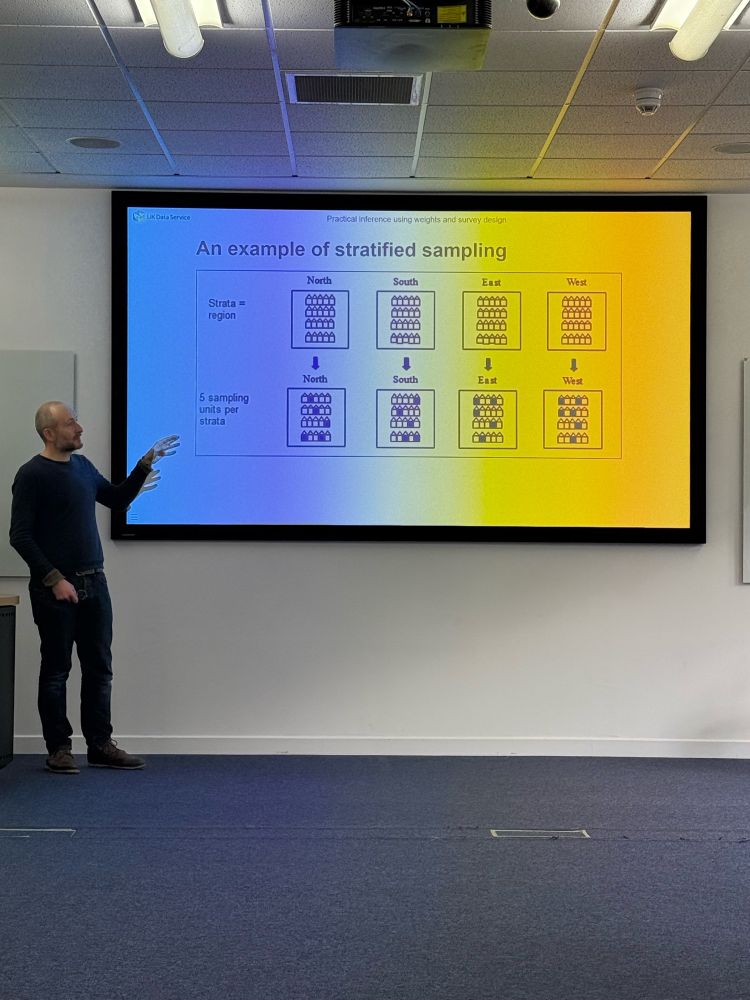
Figure 1: Private rents have been consistently above 30% in England, below 30% in Northern Ireland, and usually below 30% in Wales
ONS have published new private rented affordability analysis for 2024.
Ratios of rents to incomes dipped in 2022/23 as incomes climbed faster than rents.
Rents have been catching up so affordability has worsened again and seems likely it will continue to worsen through 2025...
18.08.2025 09:58 — 👍 6 🔁 5 💬 1 📌 1

👉OUT NOW!👈
"A Handbook of Integration with Refugees: Global Learnings from Scotland"
Edited with @alisonphipps.bsky.social and @esaldegheri.bsky.social
The book is FREE to download from www.multilingual-matters.com
13.08.2025 18:02 — 👍 6 🔁 6 💬 1 📌 0
This isn't just a statistic, it's people's family members dying before they should, and all the pain that comes with that. It's also a reflection of deep-seated structural issues.
09.07.2025 06:43 — 👍 0 🔁 0 💬 1 📌 0
In the most deprived parts of England, there were an expected 569 early deaths for every 100,00 people. The (unweighted) average in England was 446.
09.07.2025 06:43 — 👍 0 🔁 0 💬 1 📌 0
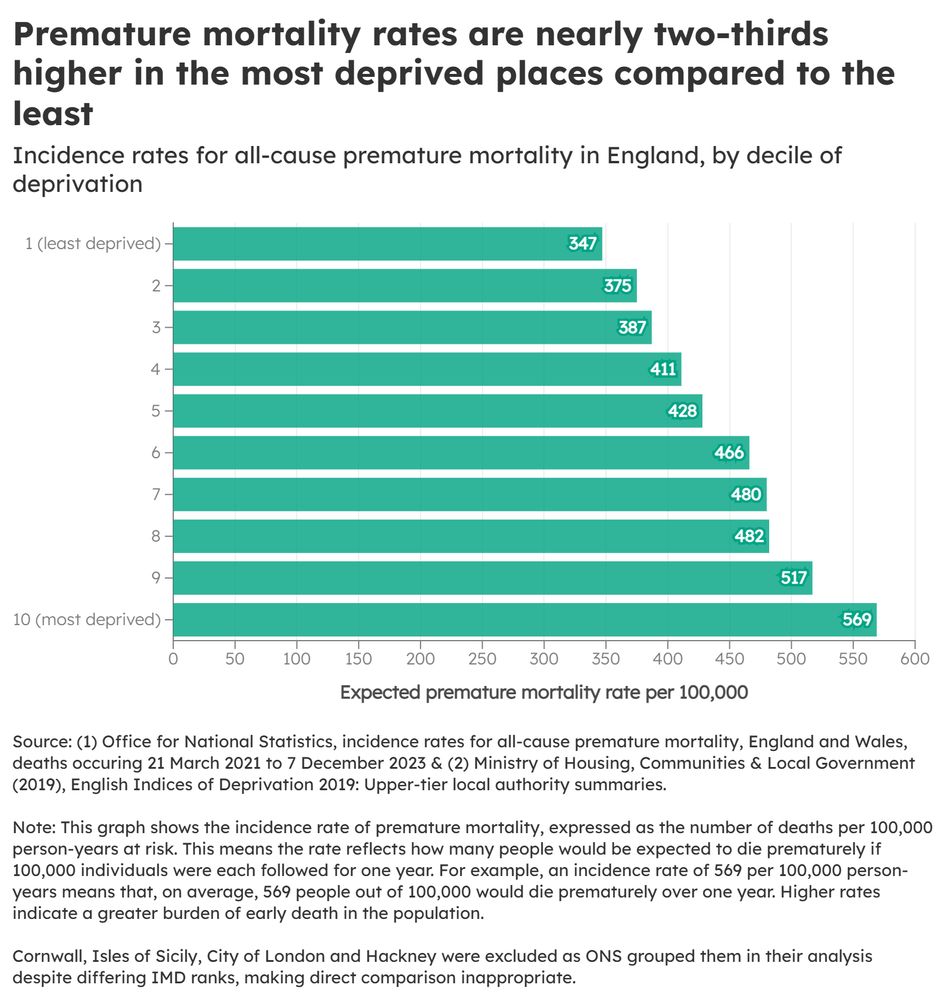
The latest figures released yesterday on premature mortality in England and Wales reveal another stark and persistent inequality: From March 2021 to December 2023, people living in the most deprived areas were 64% more likely to die prematurely than those in the least deprived places.
09.07.2025 06:43 — 👍 2 🔁 1 💬 1 📌 0
The data shows a clear and growing trend: inequality is deepening, and it’s costing people not just years of life, but years of quality life. This growing disparity highlights the urgency of addressing the social and economic factors that continue to shape unequal health outcomes across the country
04.07.2025 11:06 — 👍 0 🔁 1 💬 0 📌 1
‼️ That's a nearly 20-year gap, not in lifespan, but in the number of years lived in good health‼️
With the state pension age now at 66 (and rising), many people in the most deprived areas are spending their final working years in poor health, or not living long enough to enjoy retirement at all.
04.07.2025 11:06 — 👍 0 🔁 0 💬 1 📌 0
Between 2020 and 2022, men and women born in the most deprived areas could expect to live just 51.1 and 50.5 years in good health, respectively.
In contrast, those in the least deprived areas could expect over 70 years of healthy life.
04.07.2025 11:06 — 👍 0 🔁 0 💬 1 📌 0
🚨 New data from the Office of National Statistics (ONS) reveals a stark and persistent truth: in England, the place you're born still plays a major role in determining how well (and how long) you live.
04.07.2025 11:06 — 👍 3 🔁 6 💬 1 📌 0
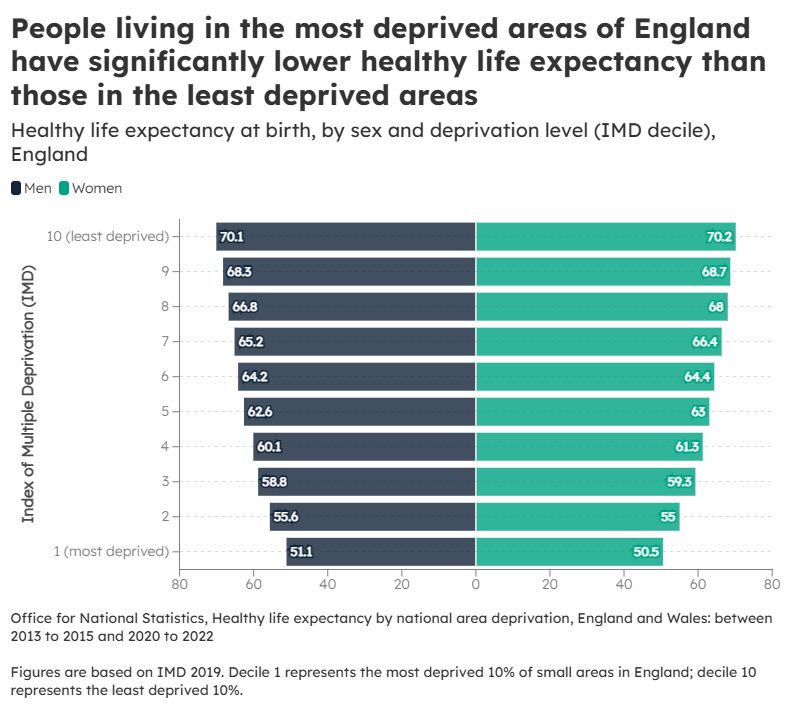
Bar chart titled "Healthy life expectancy at birth, by sex and deprivation level (IMD decile), England". The chart compares healthy life expectancy for men (dark blue bars) and women (light green bars) across ten deprivation deciles, from most deprived (Decile 1) to least deprived (Decile 10), based on the Index of Multiple Deprivation (IMD).
In Decile 1 (most deprived), healthy life expectancy is approximately 51.1 years for men and 50.5 years for women.
In Decile 10 (least deprived), it rises to about 70.1 years for men and 70.2 years for women.
The chart shows a clear upward trend in healthy life expectancy as deprivation decreases, with a nearly 20-year gap between the most and least deprived groups.
Source: Office for National Statistics (ONS), 2020–2022 data.
04.07.2025 11:06 — 👍 10 🔁 10 💬 2 📌 2

Photo of criminologists Dr Ashley Rogers, Dr Hannah Graham, and Dr Diana Miranda in graduation gowns and smiling.

Photo of Prof Peter Matthews and Dr Niall Hamilton-Smith, with Dr Ben Matthews in the background, all wearing graduation gowns at a University of Stirling graduation.

Photo of Dr Marina Shapira wearing her graduation gowns and cap, smiling.
Congratulations to our students who graduated @stir.ac.uk 👏💐🎓🎉
Hooray for Dr Beth Cairns, Dr @scothunter.bsky.social, & Dr Jade Hooper getting PhDs!
📸 Academics:
@niallhsmith.bsky.social @urbaneprofessor.bsky.social @dianamiranda.bsky.social @drashleyrogers.bsky.social @drhannahgraham.bsky.social
26.06.2025 16:40 — 👍 15 🔁 5 💬 0 📌 0
1 in 6 children in Wales has been in poverty in 3 out of the last 4 years.
🚨 Urgent, radical action from the Welsh and UK governments is needed to avoid lasting consequences.
Our report out today with the Bevan Foundation lays bare the state of poverty in Wales in 2025.
1/6
10.06.2025 06:57 — 👍 24 🔁 27 💬 1 📌 5
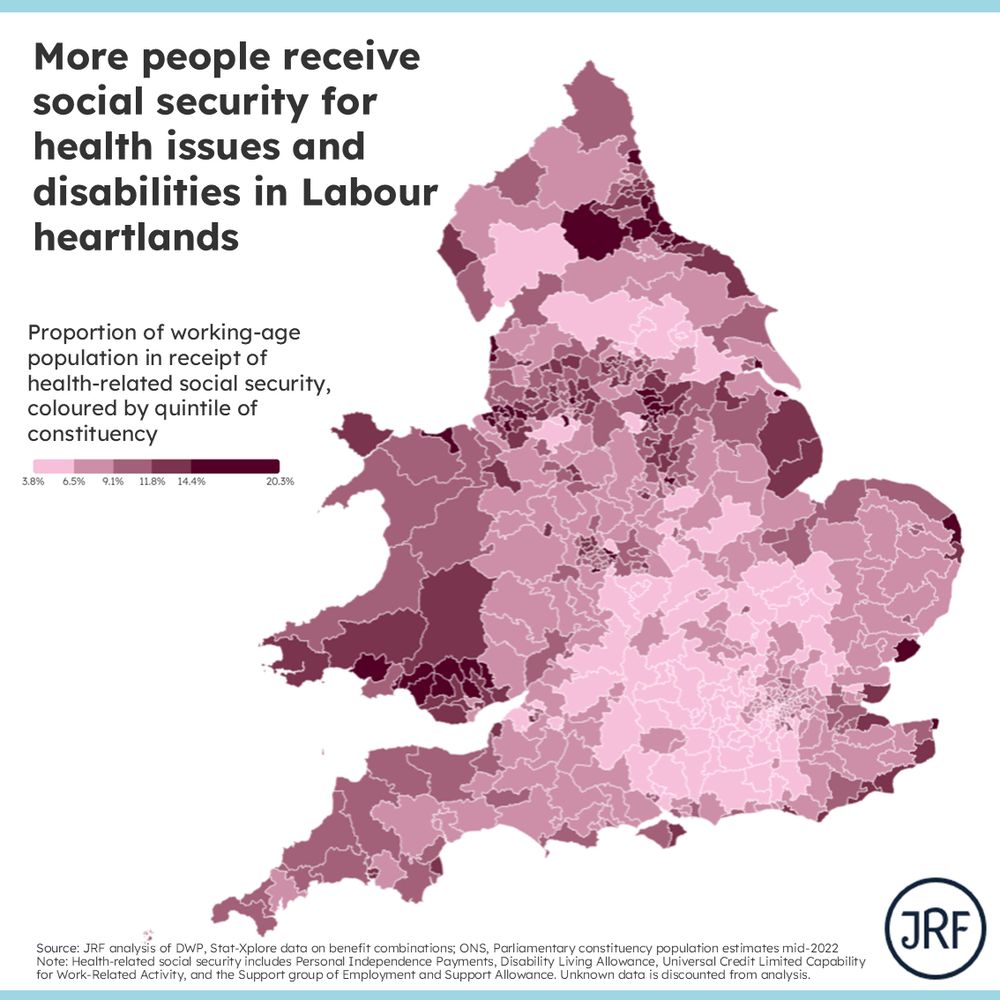
Map showing proportion of working age population in receipt of health related social security, coloured by quintile of constituency. In some coastal areas, south Wales, the North West and Yorkshire and North East, rates are between 15-20%
Where will the cuts to sickness & disability benefits hit hardest?
New @jrf-uk.bsky.social constituency analysis shows the % of working age people receiving these benefits in England & Wales.
Some MP inboxes are likely to be brimming, as concern about these plans is widespread
02.04.2025 13:06 — 👍 29 🔁 33 💬 1 📌 7
You would kind of hope that the Jobcentre might know where to find workers to fill its own vacancies really wouldn't you?
31.03.2025 09:54 — 👍 43 🔁 5 💬 2 📌 0
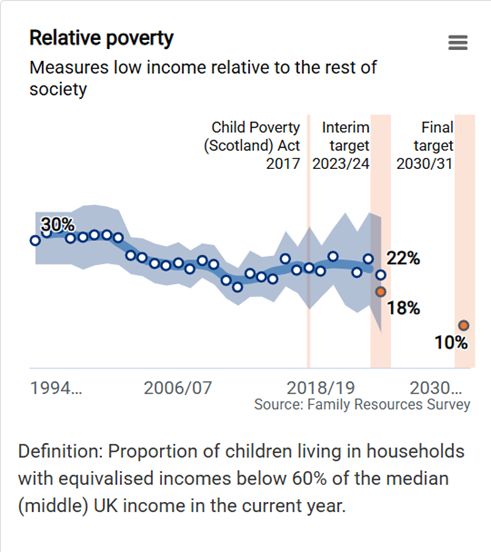
Line chart showing the trend in relative child poverty (AHC) and the child poverty reduction targets. It shows one-year estimates with large confidence intervals. The rate in 2023/24 is 22% and the interim target (also 2023/24) is 18%. In 2030/31 the final target is 10%.
Today’s poverty statistics show that the Scottish Government has failed to meet the interim child poverty reduction targets.
240,000 children is Scotland remain in poverty (AHC). To have met the targets a further 40,000 children would need to have been lifted out of poverty.
27.03.2025 14:15 — 👍 2 🔁 3 💬 1 📌 0
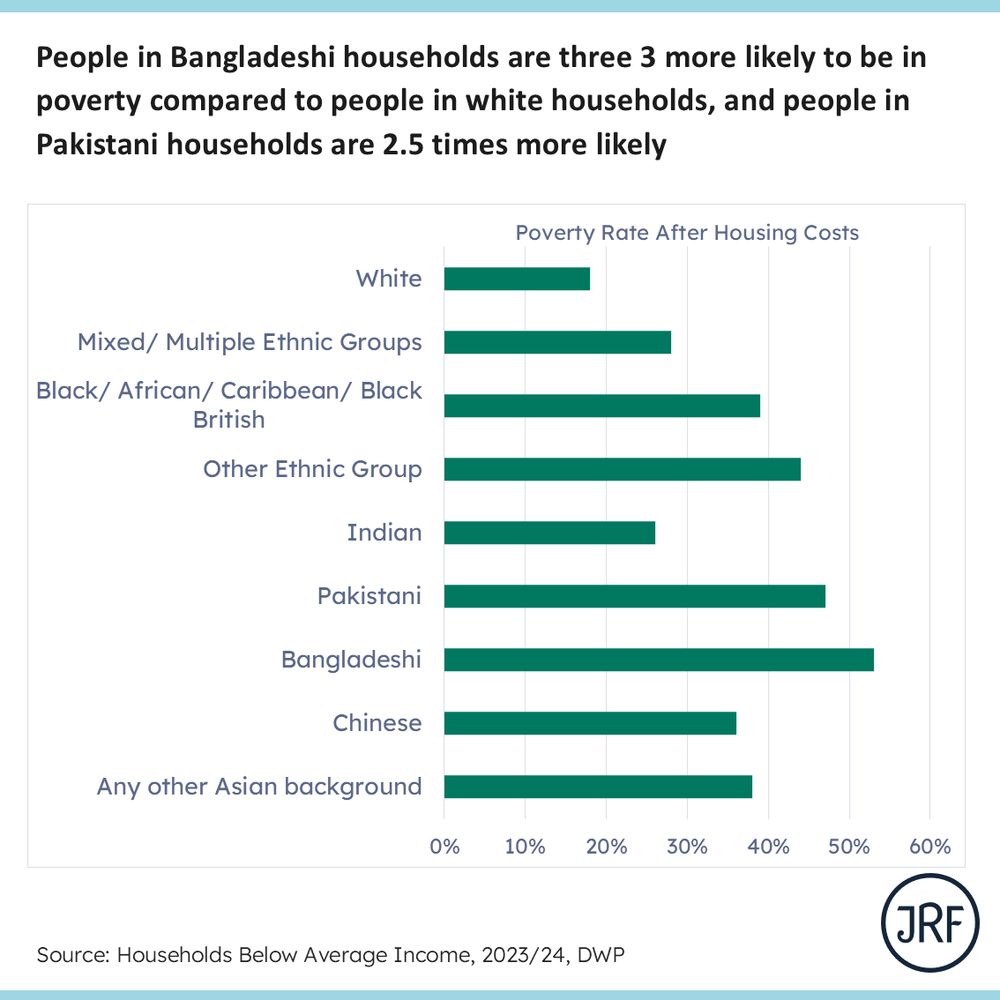
All ethnic minority groups in the UK continue to face persistent poverty with no signs of improvement from last year.
📊 New DWP figures show people in Bangladeshi households are still 3x more likely to be in poverty compared to white households, and Pakistani households are 2.5x more likely.
27.03.2025 13:16 — 👍 4 🔁 1 💬 0 📌 0
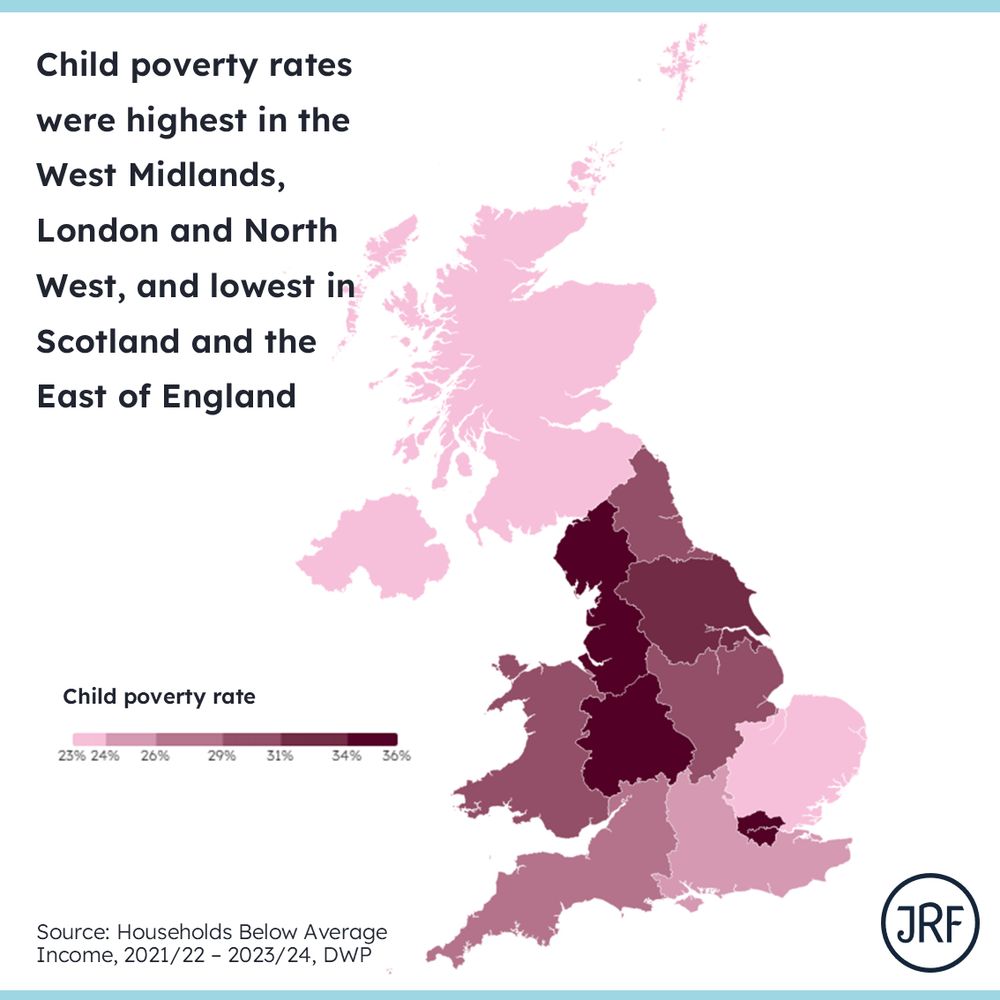
New poverty rate figures show the West Midlands, London and the North West had the highest child poverty rates with over a third of children in poverty.
In Scotland (where things are being done differently) the child poverty rate is joint lowest for the UK at 23%.
27.03.2025 12:22 — 👍 4 🔁 3 💬 1 📌 0
Around 4.5 million children are living in relative poverty after housing costs. 200,000 more since before the pandemic.
These are record numbers of children living in poverty.
Latest DWP figures on Households Below Average Income has found 🔽 1/3
27.03.2025 11:33 — 👍 39 🔁 34 💬 1 📌 4
The Chancellor said today that she would not do anything to put household finances in danger
Yet the government’s own assessment shows their cuts to health related benefits risk pushing 250,000 people into poverty, including 50,000 children 📢
Their assessment also found... 1/3
26.03.2025 14:48 — 👍 109 🔁 106 💬 2 📌 5
Yesterday, the Government’s launched the #PathwaystoWork green paper. It plans to create a “clearer youth phase” by changing benefit rules for young people to support its new Youth Guarantee.
Key takeaways 🧵1/7
19.03.2025 18:09 — 👍 8 🔁 5 💬 1 📌 1
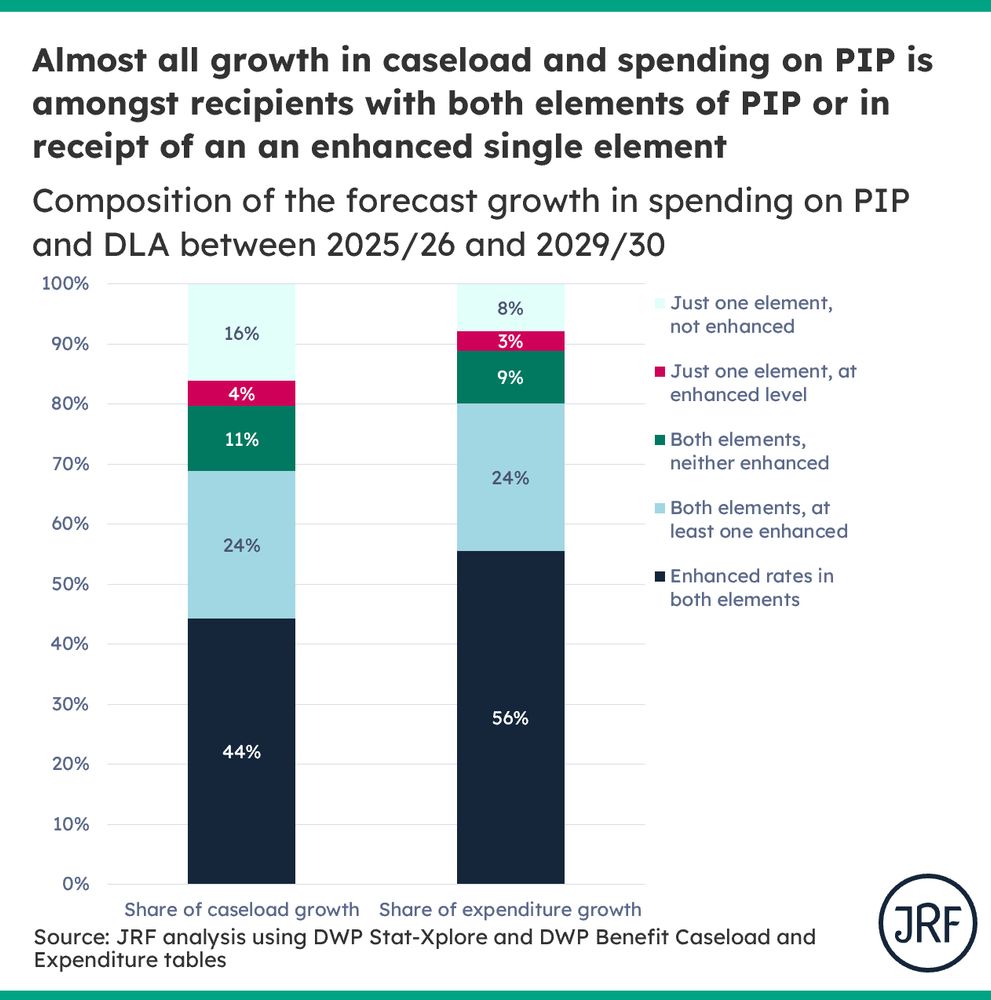
Stacked bar chart showing that the vast majority of the forecast increase in caseload and expenditure on PIP is from recipients in receipt of both elements (80% of caseload growth, 89% of spend growth) or one at the enhanced rate (increases to 84% of caseload growth, 92% of spend growth).
@jrf-uk.bsky.social has analysed caseload data and can see much of the forecast growth in PIP spending is directed at people with significant difficulties across a range of areas. Over half of the growth in spending is from people in receipt of the higher rate in both PIP elements.
17.03.2025 16:39 — 👍 24 🔁 17 💬 2 📌 2
Very pleased to have a part in this
06.03.2025 14:21 — 👍 1 🔁 0 💬 0 📌 0

Crying at the conference
03.12.2024 06:54 — 👍 1 🔁 0 💬 0 📌 0
@philippac.bsky.social
22.11.2024 14:14 — 👍 0 🔁 0 💬 0 📌 0
Lecturer at @johnsmithcentre.com, working with @uofgsocsci.bsky.social students on the annual UK Youth Poll. New book, 'Capital, Privilege, and Political Participation,' available now: https://liverpooluniversitypress.co.uk/doi/book/10.3828/9781836245902
Scotland's national refugee charity. Celebrating diversity and raising awareness about issues faced by refugees. Co-ordinators of #RefugeeFestScot.
scottishrefugeecouncil.org.uk
CEO @scotrefugeecouncil.bsky.social
🇪🇷🇬🇧 | Academic @UofGlasgow | Fellow @YoungAcademySco | @soasalumni | Views own
Sociologist teaching/researching/writing about asylum & refugee migration, community mobilisations, solidarity & resistance practices. Also writing about developing critical pedagogy in Migration Studies.
And yes the Home Office is a disgrace.
Human Rights for All |PhD researcher @UofGlasgow Art & Law in Migration| Theatre | Human Rights & Advocacy Coordinator @Maryhill_IN | Personal views
Political Geographer at the Centre for Public Policy (Glasgow). Researching border governance, asylum determination and refugee integration.
Meanjin/Brisbane-based researcher working on migration, refugee resettlement, and social cohesion.
Where I work: https://scanloninstitute.org.au/
Things I've done: https://orcid.org/0000-0003-4668-261X
Other stuff: https://www.linkedin.com/in/johnvankooy/
Author, Speaker, Peace Researcher: josef.muehlbauer@uni-graz.at
Dad|PhDing (Criminal Justice, Criminology & Law Studies) American History|Theology degrees🎣💦🥾🏕️🎸
Manc, council house lad. Army vet (RCT), ExFirefighter (GMFRS), Fire Engineer (IFE) & fire data researcher (Leeds Uni). Medically retired (Menière’s). Vertiginous, going deaf. Pioneered fire risk determination by building type. INFJ. ADHD. @HRRBFireSafety.
Gender Scholar
Researching (a)sexualities, health communication, masculinities, contraception/safer sex, repro health, climate crisis, IR, peace/conflict studies, utopias/dystopias, mental health, media, history,...
https://orcid.org/0009-0009-7802-2721
Senior Policy Advisor in NI for Joseph Rowntree Foundation
Lecturer in Social Policy at Cardiff University / WISERD. Work, welfare, devolution, civil society and youth unemployment. Views are my own. She / Her
Public Affairs @jrf-uk.bsky.social, campaigning for a fairer social security system. Previously at @trusselluk.bsky.social.
Season ticket holder at #bhafc
Researcher, Teacher and Activist focused on tackling #HealthInequalities via the University of Glasgow and the People's Health Movement Scotland (@phmscotland on here)
My shit tastes displayed on the 'Gram @twotone82
Director @ukandeu Bitter and twisted observer of politics. ‘Not yoda’ (DC) ‘Slightly matey politics don' (Q. Letts) Trustee, @fullfact #LUFC Most views someone else’s
🌹 Labour MP for Earley and Woodley, covering Shinfield & Whitley
📈 Member of the Treasury Select Committee
📚 Chair of the APPG for Social Science and Policy
✉️ Please email if you'd like a reply: yuan.yang.mp@parliament.uk
FT columnist, writing about work, technology & economics.
Director of Insight & Policy and Chief Economist at JRF | previously NEF & IPPR | "all models are wrong, but some are useful" (G Box)
















